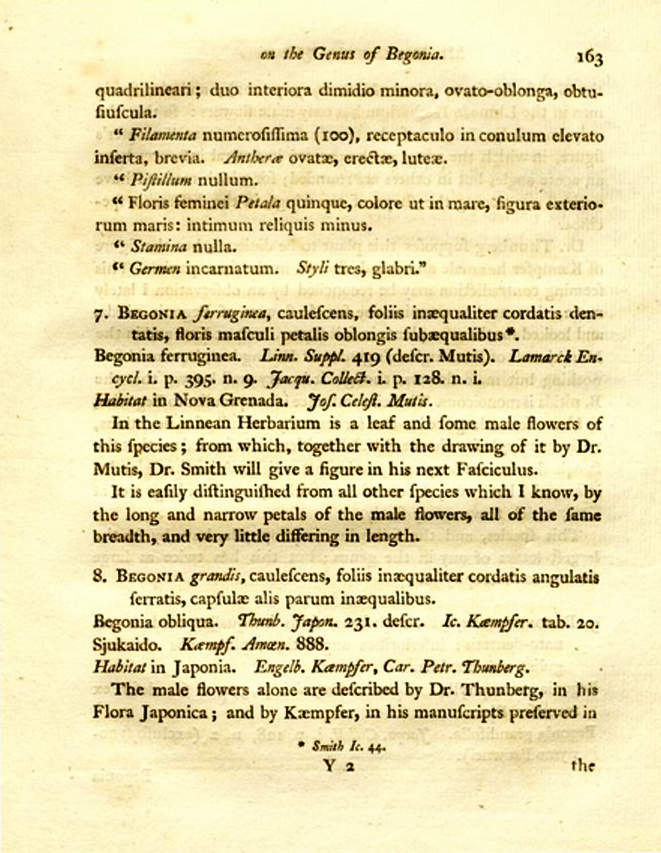La plante a été officiellement découverte le 31 décembre 2014 par une équipe de botanistes composée de Ching-I Peng avec Chien-I Huang, Rosario R. Rubite, Elizabeth P. Gironella, M. A. Suzuki, T. C. B. Cardona, à l’altitude d’environs 30 mètres, sur des falaises semi-ombragées de calcaire ou une pente rocheuse autour de la grotte de Tabon Cave, près de Lipuun Point, un site archéologique et du patrimoine naturel dans la municipalité de Quezon, sur l’île de Palawan aux Philippines.
Toutefois, la photo ci-dessous, montrant Begonia tabonensis et Begonia gutierrezii exactement au même endroit, a été prise en 2011 par Patrick Blanc.

La nouvelle espèce a été dénommée et décrite en mai 2018 par C.-I Peng, Rosario Rubite et Che-Wei Lin dans PLOSone 10.1371: pages 20 à 23 dans un article ayant pour titre Chloroplast and nuclear DNA exchanges among Begonia sect. Baryandra species (Begoniaceae) from Palawan Island, Philippines, and descriptions of five new species auquel ont collaborés Mark Hughes, C.-I Peng, C-.W. Lin, Rosario Rubite, Patrick Blanc et K.-F. Chung.
L’épithète spécifique fait référence à la grotte de Tabon où la plante a été découverte.
L’espèce fait partie de la section Baryandra.




Herbe rhizomateuse monoïque, rhizome rampant, stipules persistantes, rougeâtres, triangulaires, feuilles alternes, asymétriques, obliques, largement ovales, épaisses, glabres, gris vertapex acuminé ou aigu, bords denticulés discrètement ciliés, poils blancs, vert pâle au revers, velouté sur toutes les nervures, nervures basales palmés, nervure médiane distincte avec 2 veines secondaires de chaque côté, inflorescences en panicule axillaire, bisexuée, ramifiée, pédoncule de 6 à 15 centimètres de long, provenant directement du rhizome, bractées vert jaunâtre pâle à rosâtre, fleur mâle à 4 tépales blanc à rosé, les 2 extérieurs ové ou obové à suborbiculaire, les 2 intérieur oblancéolé, fleur femelle à 4 tépales blancs à rosés, les 2 externes obovales ou suborbiculaires, les 2 internes oblancéolés, capsule pendante, à 3 ailes, ailes sous-égales.

Pour voir d’autres photo réalisées en 2011 par Patrick Blanc, cliquez ici
Begonia tabonensis est endémique de Lipuun Point, au nord de la municipalité de Quezon, dans le sud-ouest de l’île de Palawan. Il se trouve sur les falaises de calcaire semi-ombragées autour de la grotte de Tabon, un site archéologique et du patrimoine naturel, dans la forêt de plaine. Le site est visité par les touristes, mais il est géré de manière durable par la communauté locale et la branche du Musée National de Palawan. Bien qu’il ait une petite distribution, B. tabonensis appartient à la catégorie la moins préoccupante de l’UICN tant que le site reste intact.
Begonia tabonensis ressemble à B. mindorensis Merr. dans les feuilles largement ovales, uniformément vertes et inflorescence avec des glandes sessiles, différant par des pétioles plus courts (jusqu’à 10 centimètres contre 25 cm de long); feuilles 4−8 × 4 ± 6,4 cm (contre 10−15 × 6 ± 10 cm); bractées caduques (vs persistantes), chartacées (vs coriaces), glabres ou très peu glandulaires (vs densément glandulaires); aile ovaire en forme de croissant, parfois légèrement pointue au sommet (vs triangulaire, aiguë au sommet).
The plant was officially discovered on December 31, 2014 by a team of botanists composed of Ching-I Peng with Chien-I Huang, Rosario R. Rubite, Elizabeth P. Gironella, M. A. Suzuki, T. C. B. Cardona, at an altitude of around 30 meters, on semi-shaded limestone cliffs or a rocky slope around the cave of Tabon Cave, near Lipuun Point, an archaeological and natural heritage site in the municipality of Quezon, on the island of Palawan in the Philippines.
However, the photo above this page, showing Begonia tabonensis and Begonia gutierrezii in exactly the same place, was taken in 2011 by Patrick Blanc.
The new species was named and described in May 2018 by C.-I Peng, Rosario Rubite and Che-Wei Lin in PLOSone 10.1371: pages 20 to 23 in an article entitled Chloroplast and nuclear DNA exchanges among Begonia sect. Baryandra species (Begoniaceae) from Palawan Island, Philippines, and descriptions of five new species with which Mark Hughes, C.-I Peng, C-.W. Lin, Rosario Rubite, Patrick Blanc and K.-F. Chung.
The specific epithet refers to the Tabon cave where the plant was discovered.
The species is part of the Baryandra section.
Monoecious rhizomatous grass, creeping rhizome, persistent, reddish, triangular stipules, alternate leaves, asymmetrical, oblique, broadly oval, thick, glabrous, acuminated or acute vertapex gray, discreetly ciliated denticulate edges, white hairs, pale green on the back, velvety on all the veins, webbed basal veins, distinct midrib with 2 secondary veins on each side, inflorescences in axillary panicle, bisexual, branched, peduncle 6 to 15 cm long, coming directly from the rhizome, bracts pale yellowish green to pinkish, male flower with 4 tepals white to pink, the 2 outer ovate or obovate to suborbicular, the 2 inner oblanceolate, female flower with 4 tepal white to pink, the 2 outer obovate or suborbicular, the 2 internal oblanceolate, pendant capsule, 3 wings, wings sub-equal.
Begonia tabonensis is endemic to Lipuun Point, north of the municipality of Quezon, in the southwest of the island of Palawan. It is located on the semi-shaded limestone cliffs around the Tabon cave, an archaeological and natural heritage site, in the lowland forest. The site is visited by tourists, but is managed sustainably by the local community and the branch of the Palawan National Museum. Although it has a small distribution, we consider B. tabonensis to be in the least concern category of IUCN as long as the site remains intact.
Begonia tabonensis resembles B. mindorensis Merr. in broadly oval, uniformly green leaves and inflorescence with sessile glands, differing by shorter petioles (up to 10 cm against 25 cm long); leaves 4−8 × 4 ± 6.4 cm (against 10−15 × 6 ± 10 cm); deciduous bracts (vs persistent), chartaceous (vs tough), glabrous or very little glandular (vs densely glandular); crescent-shaped ovary wing, sometimes slightly pointed at the top (vs triangular, acute at the top).



























































